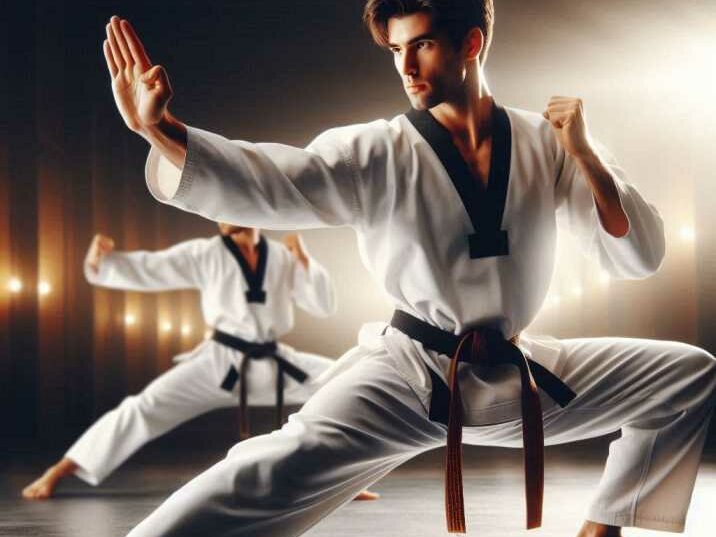Introduction:
Table of Contents
Welcome to the world of Taekwondo Poomsae, where discipline meets artistry. In this comprehensive guide, we delve into the intricate practice of Taekwondo forms, exploring their origins, techniques, and benefits. Whether you’re a novice curious about martial arts or a seasoned practitioner aiming to deepen your understanding, this article aims to provide clarity and insight into Taekwondo Poomsae.

What are Taekwondo Poomsae?
Definition and Significance in Taekwondo:
Taekwondo Poomsae, often referred to simply as “forms” or “patterns,” are choreographed sequences of movements that simulate defense and attack scenarios against multiple imaginary opponents. These forms are fundamental to Taekwondo training, serving as a means to practice techniques, develop muscle memory, and embody the principles of balance, power, and accuracy. Poomsae training emphasizes precision in execution, proper breathing techniques, and mental focus, making it an essential aspect of martial arts development.
Evolution from Traditional Forms to Modern Practice:
The evolution of Taekwondo Poomsae traces back to ancient Korean martial arts traditions. Initially, these forms were practical combat drills passed down orally and through demonstration. Over time, as Taekwondo emerged as a distinct martial art in the mid-20th century, Poomsae underwent formalization and standardization. Various Taekwondo masters and organizations contributed to refining the forms, incorporating philosophical principles and technical advancements into their structure. Modern Poomsae practice reflects a blend of traditional martial arts values with contemporary athletic training methodologies.
History of Taekwondo Poomsae:
Origins and Development through Different Taekwondo Styles:
Taekwondo Poomsae originated from ancient Korean martial arts, such as Taekkyeon and Subak, which emphasized fluid, dynamic movements and strategic combat techniques. With the formalization of Taekwondo in the 1950s and 1960s, different schools or styles of Taekwondo began to emerge, each developing their own sets of Poomsae. For instance, the Kukkiwon style (also known as World Taekwondo Federation or WTF style) and the International Taekwon-Do Federation (ITF) style have distinct sets of Poomsae with specific sequences and philosophies.
Key Figures and Influences in Shaping Poomsae:
Several influential figures have played pivotal roles in shaping Taekwondo Poomsae into what they are today. Grandmasters and pioneers like General Choi Hong Hi (founder of ITF Taekwondo) and Grandmaster Woo Jin Jung (prominent in Kukkiwon style) contributed significantly to the development and promotion of Poomsae. These leaders not only codified existing forms but also introduced new ones, blending traditional techniques with innovative approaches to enhance both practical application and aesthetic appeal.
Types and Classification:
Overview of Major Poomsae Sets (e.g., Kukkiwon, ITF):
Kukkiwon (World Taekwondo Federation/WTF) Poomsae:
Developed by Kukkiwon, the official Taekwondo governing body in South Korea, these Poomsae are widely practiced internationally. They are characterized by fluid, dynamic movements with a strong emphasis on speed, accuracy, and athleticism. The Kukkiwon Poomsae set includes eight Taegeuk forms for color belt ranks and additional black belt forms, each with increasing complexity.
International Taekwon-Do Federation (ITF) Poomsae:
Created by General Choi Hong Hi, the founder of ITF Taekwondo, these Poomsae are often referred to as “Tuls” or “patterns.” ITF Poomsae typically feature more grounded stances, powerful techniques, and distinct, historically rooted patterns. Each pattern within the ITF curriculum is designed to reflect the martial art’s traditional combat techniques and philosophical principles, with a total of 24 patterns for various belt levels.
Common Elements:
Each set within these classifications consists of specific sequences of movements that practitioners must memorize and perform with precision during training and competitions. These sequences help in developing a deeper understanding of martial arts techniques, improving physical coordination, and enhancing mental focus.
Differences Between Beginner, Intermediate, and Advanced Forms
The complexity and difficulty of Taekwondo Poomsae increase as practitioners progress from beginner to advanced levels:
Beginner Forms
Foundational Movements:
- Beginner forms introduce the basic building blocks of Taekwondo. These include fundamental kicks, blocks, punches, and strikes.
- Movements are simple and straightforward, focusing on executing each technique correctly and with proper form.
Basic Stances:
- Emphasis on mastering basic stances such as the horse stance (Juchum Seogi), front stance (Ap Kubi), and back stance (Dwit Kubi).
- Correct stance alignment is critical as it lays the groundwork for balance, stability, and power generation.
Fundamental Techniques:
- Techniques include basic front kicks (Ap Chagi), low blocks (Arae Makgi), and middle punches (Momtong Jireugi).
- These forms ensure that students develop a strong understanding of basic techniques, which are essential for progressing to more complex movements.
Introduction to Poomsae Practice:
- Beginner forms are designed to help students familiarize themselves with the concept of Poomsae.
- They teach the importance of correct posture, breathing, and timing, setting the stage for more advanced practice.
Examples:
- In the Kukkiwon system, the Taegeuk series starts with Taegeuk Il Jang, focusing on basic movements and stances.
Intermediate Forms
Building on Foundational Skills:
- Intermediate forms take the foundational skills learned in beginner forms and build upon them.
- They introduce more complex combinations of movements, requiring a deeper understanding and better coordination.
Intricate Combinations:
- Movements become more complex, incorporating multiple techniques in a single sequence.
- Techniques may include combinations like a block followed by a counterattack or a sequence of kicks and punches.
Improved Coordination, Balance, and Timing:
- Practitioners must demonstrate improved balance and coordination, executing techniques with greater precision and fluidity.
- Timing becomes more critical as students learn to transition smoothly between movements, maintaining rhythm and flow.
Incorporation of New Techniques:
- New techniques such as side kicks (Yop Chagi), high blocks (Eolgul Makgi), and backfist strikes (Deungjumeok Chigi) are introduced.
- Students also begin to learn movements that require more power and speed.
Examples:
- Taegeuk Sam Jang and Sa Jang in the Kukkiwon system introduce more complex techniques and combinations, reflecting intermediate skill levels.
Advanced Forms
Complex Sequences:
- Advanced forms are characterized by highly complex sequences of movements that challenge the practitioner’s physical and mental abilities.
- These forms often require a high level of precision, speed, and power in execution.
Rapid Transitions:
- Movements involve rapid transitions between techniques and stances, requiring excellent coordination and agility.
- Techniques such as jumping kicks, spinning kicks, and advanced blocks and strikes are common.
Advanced Techniques:
- Techniques like jumping front kicks (Twio Ap Chagi), spinning hook kicks (Dollyo Chagi), and knife-hand blocks (Sonkal Makgi) are prevalent.
- These advanced techniques demand a high degree of skill and are often more physically demanding.
Physical and Mental Challenges:
- Advanced forms challenge practitioners to push their limits, testing endurance, flexibility, and strength.
- They also require a strong mental focus, as students must remember complex sequences and execute them flawlessly under pressure.
Years of Dedicated Practice:
- Mastery of advanced forms requires years of dedicated practice and continuous refinement.
- Practitioners must regularly train and seek feedback to perfect their technique and performance.
Examples:
- In the Kukkiwon system, Taegeuk Chil Jang and Pal Jang, as well as black belt forms like Koryo and Keumgang, represent advanced forms with complex sequences and demanding techniques.
Components of a Poomsae:
Detailed Breakdown of Stances, Techniques, and Sequences:
Each Taekwondo Poomsae consists of several components that practitioners must execute with precision:
- Stances: Include fundamental stances like horse stance, front stance, back stance, and side stance. Proper stance alignment is crucial for balance, power generation, and fluid transitions between movements.
- Techniques: Incorporate a variety of kicks, punches, blocks, strikes, and defensive maneuvers. Techniques vary in speed, power, and application depending on the Poomsae’s specific requirements.
- Sequences: Comprise a series of connected movements that flow logically from one to the next. Sequences are designed to simulate practical combat scenarios and emphasize the principles of offense, defense, and counter-attack.
Importance of Precision and Flow in Execution:
Precision and flow are essential elements of successful Poomsae performance:
- Precision: Refers to the exactness with which each movement, stance, and technique is executed. Judges evaluate precision based on factors such as alignment, timing, and accuracy of movements.
- Flow: Involves smooth transitions between movements, demonstrating seamless connectivity and rhythm throughout the entire Poomsae. Flow enhances the aesthetic quality of performance and reflects a practitioner’s mastery of technique and control.
Training Methods and Benefits:
Strategies for Effective Poomsae Training:
Effective training methods play a crucial role in developing proficiency in Taekwondo Poomsae:
- Regular Practice: Consistent practice is essential for memorizing forms, improving technique, and building muscle memory.
- Focus on Fundamentals: Emphasize correct posture, stance alignment, and technique execution during training sessions.
- Progressive Learning: Gradually increase the complexity and speed of movements as proficiency improves.
Physical, Mental, and Spiritual Benefits for Practitioners:
Training in Taekwondo Poomsae offers a wide range of benefits beyond physical fitness:
Competitions and Evaluation:
How Poomsae Competitions are Structured and Judged:
Judging Criteria:
Judges evaluate Poomsae performances based on specific criteria such as accuracy, power, balance, rhythm, and overall presentation. Each movement’s precision and technical correctness are scrutinized to ensure high standards.
Scoring System:
Scores are awarded according to the quality of execution, with deductions for errors in technique, form, or sequence. The scoring system aims to reflect the practitioner’s proficiency and adherence to Poomsae standards.
Categories:
Poomsae competitions are often divided into categories based on age groups, belt ranks, and individual or team performances. This structure allows for fair competition among participants of similar skill levels and demographics.
Tips for Preparing and Excelling in Competitions:
Practice Routine:
Establish a consistent practice routine that includes warm-ups, form practice, and cooldown exercises. Regular practice helps in refining techniques and improving overall performance.
Visualization:
Mentally rehearse each Poomsae sequence and visualize flawless execution. This technique builds confidence, enhances focus, and prepares the mind for actual competition scenarios.
Feedback and Adjustments:
Regularly seek feedback from instructors and peers to identify areas needing improvement. Use constructive criticism to make necessary adjustments and enhance performance before competitions.

Table of Information
| Section | Subsection | Details |
|---|---|---|
| Introduction | Overview of Taekwondo Poomsae, their significance, techniques, and benefits. | |
| What are Taekwondo Poomsae? | Definition and Significance | Choreographed movements simulating defense/attack; crucial for technique, muscle memory, and focus. |
| Evolution | From ancient Korean combat drills to standardized modern forms blending tradition and innovation. | |
| History | Origins and Development | Roots in Taekkyeon/Subak; different styles (e.g., Kukkiwon, ITF) developed unique Poomsae. |
| Key Figures | Influences from General Choi Hong Hi, Grandmaster Woo Jin Jung, and others in shaping Poomsae. | |
| Types and Classification | Major Sets (Kukkiwon, ITF) | Kukkiwon: Fluid, dynamic; ITF: Grounded, powerful; both have distinct sequences and philosophies. |
| Beginner to Advanced Forms | Forms increase in complexity from foundational to advanced techniques and combinations. | |
| Components | Breakdown of Movements | Stances, techniques, and sequences focusing on precision and flow. |
| Training and Benefits | Strategies | Consistent practice, fundamentals, progressive learning. |
| Physical Benefits | Enhances flexibility, strength, endurance, and coordination. | |
| Mental Benefits | Improves concentration, discipline, and mental resilience. | |
| Spiritual Benefits | Fosters inner peace, mindfulness, and connection to Taekwondo philosophy. | |
| Competitions | Structure and Judging | Judged on accuracy, power, balance, rhythm, and presentation; categorized by age, rank, individual/team. |
| Preparation Tips | Regular practice, visualization, seeking feedback for improvement. | |
| Conclusion | Poomsae combines physical, mental, and spiritual growth, enriching the Taekwondo journey. | |
| FAQs |
Conclusion
Taekwondo Poomsae is a vital aspect of Taekwondo, combining physical skill with mental discipline and spiritual growth. From beginner to advanced forms, Poomsae offers a structured path for continuous improvement, emphasizing precision, focus, and dedication. Training in Poomsae enhances physical fitness, mental clarity, and philosophical understanding, making it a holistic martial arts practice. Whether you are a novice or a seasoned practitioner, embracing Poomsae can significantly enrich your Taekwondo journey, fostering a harmonious balance of mind, body, and spirit.
FAQs:
- What is the purpose of Taekwondo Poomsae?
- Answer: Taekwondo Poomsae serve as structured sequences of movements that integrate the techniques and philosophies of Taekwondo, promoting physical and mental discipline.
- How many Taekwondo Poomsae are there?
- Answer: There are several sets of Taekwondo Poomsae, with different styles and organizations featuring varying numbers. For instance, Kukkiwon Taekwondo has eight Taeguk Poomsae and various black belt Poomsae.
- How do you practice Taekwondo forms alone?
- Answer: Practicing Taekwondo Poomsae alone involves memorizing the sequences, focusing on technique, balance, and fluidity of movements. Regular solo practice enhances muscle memory and proficiency.
- What are the benefits of learning Taekwondo Poomsae?
- Answer: Benefits include improved physical fitness, flexibility, concentration, self-discipline, and a deeper understanding of Taekwondo principles and techniques.
- How do judges score Taekwondo Poomsae competitions?
- Answer: Judges evaluate Poomsae based on criteria such as accuracy, power, balance, rhythm, and presentation. Each movement’s precision and overall performance determine scores.


